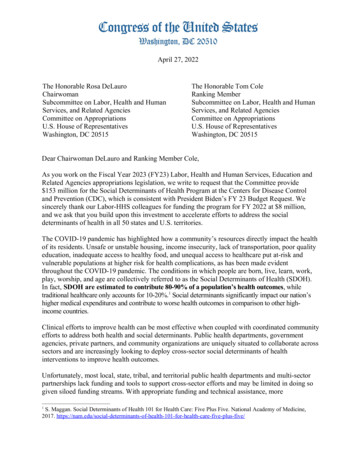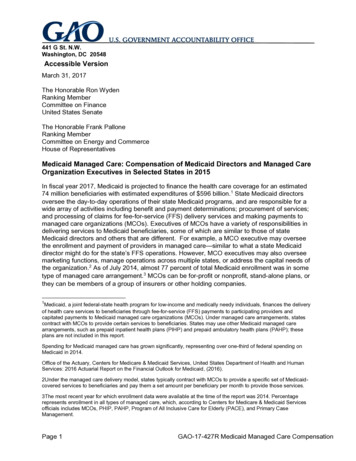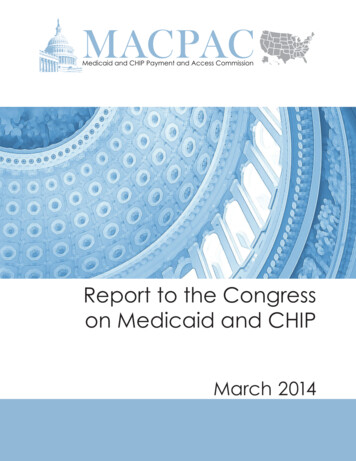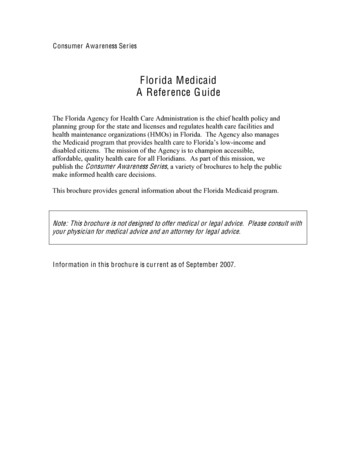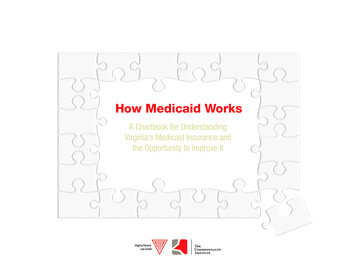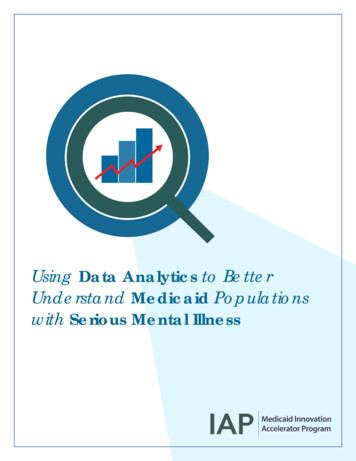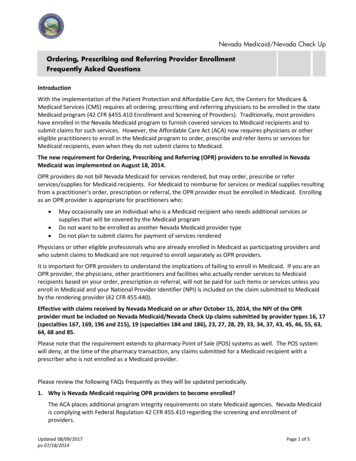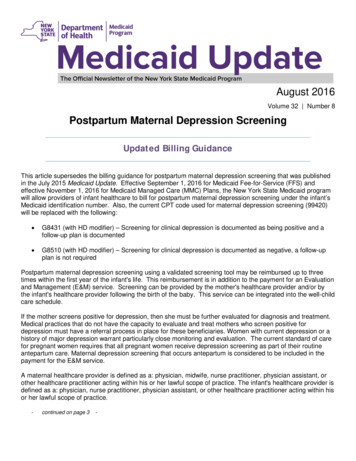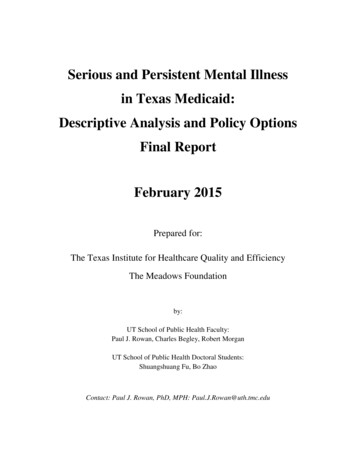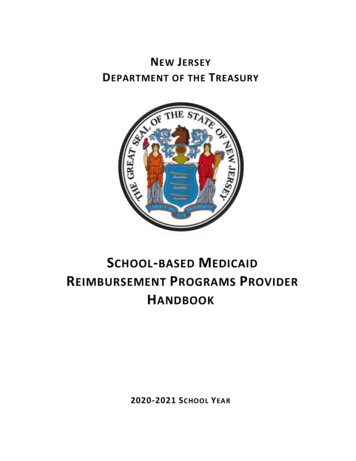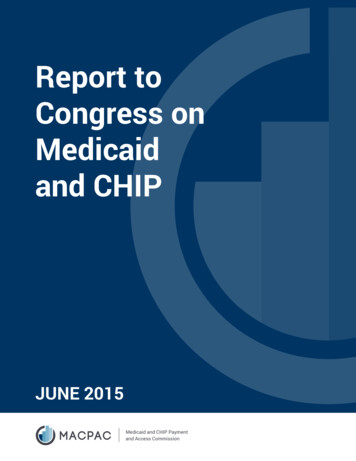
Transcription
Report toCoveronCongressMedicaidGoesand CHIPHereJUNE 2015Medicaid and CHIP Paymentand Access Commission
About MACPACThe Medicaid and CHIP Payment and Access Commission (MACPAC) is a non-partisan legislative branchagency that provides policy and data analysis and makes recommendations to Congress, the Secretaryof the U.S. Department of Health and Human Services, and the states on a wide array of issues affectingMedicaid and the State Children’s Health Insurance Program (CHIP). The U.S. Comptroller General appointsMACPAC’s 17 commissioners, who come from diverse regions across the United States and bring broadexpertise and a wide range of perspectives on Medicaid and CHIP.MACPAC serves as an independent source of information on Medicaid and CHIP, publishing issuebriefs and data reports throughout the year to support policy analysis and program accountability.The Commission’s authorizing statute, 42 USC 1396, outlines a number of areas for analysis, including: payment; eligibility; enrollment and retention; coverage; access to care; quality of care; and the programs’ interaction with Medicare and the health care system generally.MACPAC’s authorizing statute also requires the Commission to submit reports to Congress by March 15and June 15 of each year. In carrying out its work, the Commission holds public meetings and regularlyconsults with state officials, congressional and executive branch staff, beneficiaries, health care providers,researchers, and policy experts.
Report toCongress onMedicaidand CHIPJUNE 2015Medicaid and CHIP Paymentand Access Commission
Advising Congress onMedicaid and CHIP PolicyCommissionersJune 15, 2015Diane Rowland, ScD, ChairMarsha Gold, ScD, Vice ChairSharon Carte, MHSDonna Checkett, MPA, MSWAndrea Cohen, JDGustavo Cruz, DMD, MPHPatricia Gabow, MDHerman Gray, MD, MBAMark Hoyt, FSA, MAAAYvette LongNorma Martínez RogersPhD, RN, FAANCharles Milligan, JD, MPHSheldon Retchin, MD, MSPHPatricia Riley, MSSara Rosenbaum, JDPeter Szilagyi, MD, MPHSteven Waldren, MD, MSThe Honorable Joseph R. Biden, Jr.President of the SenateU.S. CapitolWashington, DC 20510Anne L. Schwartz, PhDExecutive DirectorThe Honorable John A. BoehnerSpeaker of the HouseU.S. House of RepresentativesWashington, DC 20515Dear Mr. Vice President and Mr. Speaker:On behalf of the Medicaid and CHIP Payment and Access Commission(MACPAC), I am pleased to submit MACPAC’s June 2015 Report to Congresson Medicaid and CHIP. MACPAC is a non-partisan legislative branch agencythat provides policy and data analysis and makes recommendations toCongress, the Secretary of the U.S. Department of Health and HumanServices, and the states on a wide array of issues affecting Medicaid andthe State Children’s Health Insurance Program (CHIP). This document fulfillsour statutory mandate to report each year by June 15.Next month, Medicaid will celebrate its 50th anniversary. Appropriately, theJune 2015 report focuses on several aspects of Medicaid’s longstandingmission to ensure access to high quality health services for the mostvulnerable Americans and looks to the program’s future as a major healthcare payer driving health system change towards value.The report opens with an examination of Delivery System Reform IncentivePayment (DSRIP) programs operating under waivers in several states.DSRIP programs are targeting supplemental payments, long importantto safety-net providers, toward achievement of better health and moreefficient systems. Interviews with states, providers, and other stakeholderssuggest that DSRIPs have the potential to drive value and improved healthoutcomes in Medicaid, but the programs could benefit from more clarityand consistency in federal guidance as well as an examination of lessonslearned across states to underpin future expansion.The report reviews access to dental care for adults covered by Medicaid.Poor oral health disproportionately affects adults living in poverty, who aremore than three times as likely to have untreated cavities as those withhigher incomes. While state Medicaid programs must cover dental benefitsfor children, providing adult dental coverage is a state option, and theseservices are often cut when budgets are tight. MACPAC’s analysis showsthat state Medicaid programs vary considerably in the dental services theyoffer adults, and that access to regular dental care is challenging in manyareas of the country.Medicaid and CHIP Paymentand Access Commission1800 M Street NWSuite 650 SouthWashington, DC 20036www.macpac.gov202-350-2000202-273-2452
We also examine Medicaid’s role providing access to health care for specific groups of especiallyvulnerable populations: children under the protection of child welfare authorities and individuals withbehavioral health conditions. As a first step in examining how Medicaid pays for and delivers behavioralhealth services, this report provides a detailed picture of Medicaid beneficiaries diagnosed with mentalhealth conditions and substance use disorders. Ranging from young children in need of early interventionservices to adults with serious mental illness to frail elders affected by depression and dementia,this report looks at these individuals’ need for and use of Medicaid services. These analyses lay thegroundwork for an extended inquiry into identifying targeted policies and practices for improving carefor Medicaid enrollees with different behavioral health needs while containing spending and promotingeffective and efficient service delivery.We also examine the use of psychotropic medications among Medicaid beneficiaries, noting that almosthalf of children and adults who qualify for Medicaid on the basis of disability and nearly a quarter ofchildren eligible based on child welfare assistance use psychotropic medications. In addition to describingthe extent to which these medications are being used, the chapter also highlights promising federal andstate activities to ensure safe and effective prescribing practices.MACPAC is committed to providing in-depth, non-partisan analyses of Medicaid and CHIP and theseprograms’ impact on beneficiaries, states, providers, and the broader health care sector. The scope oftopics covered in this report highlight the complex health needs and cost challenges in providing careto Medicaid’s diverse and vulnerable populations. We hope our work will prove useful to Congress as itconsiders legislative changes to Medicaid and CHIP.Sincerely,Diane Rowland, ScDChairEnclosureMedicaid and CHIP Paymentand Access Commission
Commission Members and TermsCommission Members and TermsDiane Rowland, ScD, ChairWashington, DCMarsha Gold, ScD, Vice ChairWashington, DCTerm Expires December 2015Donna Checkett, MPA, MSWPhoenix, AZPatricia Riley, MSBrunswick, MEPatricia Gabow, MDDenver, CODiane Rowland, ScDWashington, DCMark Hoyt, FSA, MAAAPhoenix, AZSteven Waldren, MD, MSLeawood, KSTerm Expires December 2016Sharon Carte, MHSSouth Charleston, WVNorma Martínez Rogers, PhD, RN, FAANSan Antonio, TXAndrea Cohen, JDNew York, NYSara Rosenbaum, JDWashington, DCHerman Gray, MD, MBADetroit, MITerm Expires December 2017Gustavo Cruz, DMD, MPHNew York, NYCharles Milligan, JD, MPHAlbuquerque, NMMarsha Gold, ScDWashington, DCSheldon Retchin, MD, MSPHColumbus, OHYvette LongPhiladelphia, PAPeter Szilagyi, MD, MPHLos Angeles, CAReport to Congress on Medicaid and CHIPvii
Commission StaffCommission StaffAnne L. Schwartz, PhD, Executive DirectorOffice of the Executive DirectorAnnie Andrianasolo, MBA, Executive AssistantKathryn Ceja, Director of CommunicationsLaura Beth Pelner, Communications/Graphic DesignSpecialistPolicy DirectorsAmy Bernstein, ScD, MHSAPolicy Director and Contracting OfficerMoira Forbes, MBA, Policy DirectorApril Grady, MPAff, Policy DirectorMary Ellen Stahlman, MHSA, Policy andCongressional Affairs DirectorPrincipal AnalystsMartha Heberlein, MAAnna Sommers, PhD, MS, MPAffJoanne Jee, MPHJames Teisl, MPHChris Peterson, MPPKristal Vardaman, MSPHSenior AnalystsVeronica Daher, JDChris Park, MSBenjamin Finder, MPHKatie Weider, MPHRobert Nelb, MPHAnalystSarah Melecki, MPAffResearch AssistantNicholas ElanOperations and ManagementRicardo Villeta, MBA, Deputy Director of Operations,Finance, and ManagementSaumil Parikh, MBA, IT SpecialistJames Boissonnault, MA, Chief Information OfficerEileen Wilkie, Administrative OfficerKen Pezzella, Chief Financial OfficerBenjamin Granata, Finance/Budget SpecialistviiiJune 2015
AcknowledgementsAcknowledgementsThe Commission gratefully acknowledges the following health policy experts, federal and state officials,and colleagues, whose contributions of expertise, perspective, and time were essential in preparing theJune 2015 Report to Congress on Medicaid and CHIP:Policy expertsKamala Allen, Evelyne Baumrucker, Deborah Briggs, Trish Young Brown, Lindsey Browning, Christine CarlsonGlazer, Stacey Chazin, Sarah Cook, Beth Feldpush, Fred Fisher, Jocelyn Guyer, Felicia Heider, Sean Hopkins,Carol Huber, Suzanne Ianni, Neva Kaye, Deborah Brown Kozick, Aaron Larrimore, Kristen Lloyd, Andrea Maresca,Tami Mark, Maureen Milligan, Erica Murray, Sheila Pires, Jill Rosenthal, Matt Salo, Melanie Schoenberg,Emilie Stoltzfus, Claudine Swartz, Moira Szilagyi, Maria Rosa Watson, Cassandra Yarbrough, and Julie Zito;Medicaid, CHIP, and state health officialsJoanne Balog, Emilie Becker, Diane Cardaciotto, William Conroy, Valerie Harr, Ardas Khalsa, Julie Lovelady,Shannon McMahon, and Tianna Morgan; andFederal officialsCarol Backstrom, Paul Boben, Mary Botticelli, Jeffrey Buck, Stephen Cha, JooYeun Chang, Eliot Fishman,Marielle Kress, Marsha Lillie-Blanton, Lynn Douglas Mouden, Laurie Norris, Laura Pratt, Ramesh Raghavan,and Vikki Wachino.The Commission also would like to express our thanks to the participants of Delivery System ReformIncentive Payment program site visits and interviews, who informed the work on Chapter 1; Tammy Luo,Steven Merry, Nebyou Solomon, Suzanne Worth, and Xiao Xiao at Acumen, LLC, for their careful dataand programming support; Paula Gordon for her indispensable copy editing; and Kevin Kempske and histalented team at GKV for their assistance in publishing this report.Report to Congress on Medicaid and CHIPix
Table of ContentsTable of ContentsCommission Members and Terms . viiCommission Staff . viiiAcknowledgements . ixExecutive Summary . xvChapter 1: Using Medicaid Supplemental Payments to Drive Delivery System Reform . 1Medicaid Supplemental Payments . 4History of DSRIP Programs . 4DSRIP Program Design . 6DSRIP Program Summaries . 10MACPAC Interviews and Site Visits . 15Policy Implications . 17Endnotes . 19References . 20Chapter 2: Medicaid Coverage of Dental Benefits for Adults . 23The Impact of Poor Oral Health . 25Public and Private Coverage of Dental Services . 26Adult Dental Benefits in Medicaid . 27Use of Dental Services . 33Efforts to Improve Access to Dental Services . 35Endnotes . 37References . 37APPENDIX 2A: State Dental Benefits Policies, as of February 2015 . 46Chapter 3: The Intersection of Medicaid and Child Welfare . 55Child Welfare Overview . 58Medicaid’s Role for Child Welfare-Involved Children and Youth . 59Selected Policy Issues . 72Conclusion . 78Endnotes . 78References . 80APPENDIX 3A: Child Welfare Population Identified in Selected Data Sources . 87xJune 2015
Table of ContentsChapter 4: Behavioral Health in the Medicaid Program—People, Use, and Expenditures . 89Medicaid Enrollees with Behavioral Health Conditions . 91Children and Youth . 96Adults under Age 65 . 103Non-Dually Eligible Adults under Age 65 . 109Enrollees Dually Eligible for Medicare and Medicaid . 112Conclusion . 115Endnotes . 116References . 116APPENDIX 4A: Background on Data and Methods. 119Chapter 5: Use of Psychotropic Medications among Medicaid Beneficiaries . 123Medicaid Psychotropic Utilization and Spending . 125Risks of Psychotropic Medications . 134Psychotropic Prescribing Guidelines . 135Evidence of Inappropriate Psychotropic Use . 135Activities to Improve Use of Psychotropic Medications . 136Looking Forward . 140Endnotes . 140References . 141APPENDIX 5A: Psychotropic Drugs Included in MACPAC Analysis . 146APPENDIX 5B: Analysis Methodology . 147Appendix . 149Authorizing Language from the Social Security Act (42 USC 1396) . 150Biographies of Commissioners . 157Biographies of Staff . 162Report to Congress on Medicaid and CHIPxi
Table of ContentsList of FiguresFIGURE 1-1. Types of Delivery System Reform Incentive Payment (DSRIP) Program Milestones . 7FIGURE 2-1. Medicaid Dental Benefits for Non-Pregnant, Non-Disabled Adults, 2015 . 31FIGURE 2-2. Changes in Medicaid Adult Dental Benefits by State, 2003–2012 . 32FIGURE 2-3. Percentage of Adults Age 21 and Older Who Had a Dental Visit Versus Doctor orOther Office-Based Medical Provider Visit in Past Year, 2012 . 34FIGURE 3-1. Number of Children in Families Investigated by Child Welfare Agencies, FY 2013 . 60FIGURE 4-1. Percentage of Non-Dually Eligible Medicaid Enrollees under Age 65 with aBehavioral Health Diagnosis by Basis of Eligibility, 2011 . 95FIGURE 4-2. Most Common Behavioral Health Diagnoses of Children Eligible for Medicaid on aBasis Other than Disability or Child Welfare Assistance, 2011 . 99FIGURE 4-3. Total Medicaid Spending Per Enrolled Child Eligible for Medicaid on a Basis Otherthan Disability or Child Welfare Assistance, with and without a Behavioral HealthDiagnosis, 2011 . 100FIGURE 4-4. Most Common Behavioral Health Diagnoses of Children Eligible for Medicaid onthe Basis of Child Welfare Assistance, 2011 . 101FIGURE 4-5. Total Medicaid Spending Per Enrolled Child Eligible for Medicaid on the Basis ofChild Welfare Assistance, with and without a Behavioral Health Diagnosis, 2011 . 102FIGURE 4-6. Most Common Behavioral Health Diagnoses of Children Eligible for Medicaid onthe Basis of Disability, 2011 . 103FIGURE 4-7. Total Medicaid Spending Per Enrolled Child Eligible for Medicaid on the Basis ofDisability, with and without a Behavioral Health Diagnosis, 2011 . 104FIGURE 4-8. Most Common Behavioral Health Diagnoses for Non-Dually Eligible Adults Age 21–64Enrolled in Medicaid, by Basis of Eligibility, 2011 . 110FIGURE 4-9. Total Medicaid Spending Per Non-Dually Eligible Adult Age 21–64 Enrolled in Medicaidon the Basis of Disability, with and without a Behavioral Health Diagnosis, 2011 . 111FIGURE 4-10. Total Medicaid Spending Per Adult Age 21–64 Enrolled in Medicaid on a Basis Otherthan Disability, with and without a Behavioral Health Diagnosis, 2011 . 112xiiJune 2015
Table of ContentsList of TablesTABLE 1-1. Summary of Current Delivery System Reform Incentive Payment (DSRIP)Programs, 2015 . 11TABLE 2-1. Types of Adult Dental Services Covered for Non-Pregnant, Non-Disabled Adultsunder Medicaid, 2015 . 28TABLE 2-2. Medicaid Dental Benefits for Non-Pregnant, Non-Disabled Adults by State, as ofFebruary 2015 . 29TABLE 2A-1. Medicaid Adult Dental Benefits and Limits by State, as of February 2015 . 46TABLE 2A-2. Relevant Dental Policy Restrictions by State . 52TABLE 3-1.Risk Factors Associated with Families Investigated by Child Welfare Agencies . 59TABLE 3-2.Characteristics of the Foster Care Population, FY 2013 . 61TABLE 3-3.Pathways to Medicaid Eligibility by Child Welfare Population and Title IV-E Status . 64TABLE 3-4. Children in Medicaid Using Behavioral Health Services by Service Type and Basis ofEligibility, 2005 . 70TABLE 3A-1. Population Identified in Child Welfare Versus Federal Medicaid Data . 87TABLE 4-1. Utilization and Spending by Medicaid Enrollees with Behavioral Health Diagnoses byAge and Basis of Eligibility, 2011 . 94TABLE 4-2. Overall Health Status and Prevalence of Health Conditions among Children underAge 18 by Insurance Status, 2011–2012 . 97TABLE 4-3. Mental Health Status and Treatment for Non-Institutionalized Adults Age 18–64 byInsurance Status, 2010–2012 . 105TABLE 4-4. Sociodemographic Characteristics of Non-Institutionalized Adults Age 18–64 withAny Mental Illness or Substance Use Disorder by Insurance Status, 2010–2012 . 106TABLE 4-5. Comorbid Medical Conditions among Non-Dually Eligible Adults Age 21–64 with andwithout a Behavioral Health Diagnosis by Basis of Eligibility, 2011 . 109TABLE 4-6. Behavioral Health Conditions of Adults Dually Enrolled in Fee-for-Service Medicaid andMedicare and Non-Dually Eligible Adults Enrolled in Fee-for-Service Medicare, 2010 . 114TABLE 4A-1. Utilization and Spending for Full-Year and Part-Year Medicaid Enrollees withBehavioral Health Diagnoses by Age and Basis of Eligibility, 2011 . 120TABLE 4A-2. Chronic Illness and Disability Payment System (CDPS) Behavioral Diagnosis Categories . 121TABLE 5-1.Medicaid Prescription Drug Utilization and Spending, CY 2011 . 127TABLE 5-2.Medicaid Psychotropic Drug Utilization and Spending by Eligibility Group, CY 2011 . 128Report to Congress on Medicaid and CHIPxiii
Table of ContentsTABLE 5-3. Medicaid Psychotropic Drug Utilization and Spending by Eligibility Group forFee-for-Service Only Enrollees, CY 2011 . 129TABLE 5-4.Medicaid Psychotropic Drug Utilization by Eligibility Group, CY 2011 . 129TABLE 5-5. Distribution of Medicaid Psychotropic Drug Users by Number of Drug Claims andEligibility Group, CY 2011 . 130TABLE 5-6. Share of Psychotropic Drug Users by Eligibility Group and Number of Months withClaim for Full-Year Medicaid Enrollees, CY 2011 . 131TABLE 5-7. Distribution of Medicaid Psychotropic Drug Utilization and Spending by Drug Class,CY 2011 . 132TABLE 5-8. Share of Medicaid Beneficiaries Using Psychotropic Drugs by Drug Class andEligibility Group, CY 2011 . 132TABLE 5-9. Medicaid Psychotropic Drug Use among Children by Eligibility and Age Group, CY 2011 . 133TABLE 5-10. Psychotropic Drug Use among Individuals Eligible on the Basis of Disability byAge Group, CY 2011 . 134TABLE 5A-1. Psychotropic Drug Classes and Representative Drugs . 146xivJune 2015
Executive SummaryExecutive SummaryAs the Medicaid and CHIP Payment and AccessCommission (MACPAC) releases its June 2015Report to Congress on Medicaid and CHIP, Medicaidmarks its fiftieth year as a unique federal-statepartnership working to ensure that low-incomeAmericans have access to comprehensive,affordable health care coverage.In addition to highlighting the complex healthneeds and cost challenges in providing care toMedicaid’s diverse and vulnerable populations,the June 2015 report looks to Medicaid’s future asa major health care payer driving health systemchange toward value. Chapter 1 examines a newapproach to supplemental payments embodiedin Delivery System Reform Incentive Payment(DSRIP) programs. Supplemental payments havelong been used to sustain safety-net providersin their communities. DSRIP programs offer theadded potential of driving value and improvedhealth outcomes in Medicaid by linking payment toachievement of specific milestones.Chapter 2 discusses coverage of adult dentalbenefits. Although Medicaid requires states toprovide dental coverage for children, such coverageis not mandatory for adults. Chapter 2 comparesMedicaid dental coverage available to low-incomeadults across the country over the past few years,and finds that benefits vary considerably betweenstates and fluctuate over time.Chapters 3 and 4 describe Medicaid’s role inproviding health services to two especially vulnerablegroups of beneficiaries: people of all ages whohave a behavioral health diagnosis and childrenand youth who receive child welfare assistance.Chapter 5 concludes the report with a discussion ofthe use of psychotropic medications under Medicaid.While psychotropic drugs are important tools inmental illness treatment, some recent studies havequestioned whether they are overprescribed.Report to Congress on Medicaid and CHIPChapter 1: Using MedicaidSupplemental Payments to DriveDelivery System ReformDSRIPs are a new type of Medicaid supplementalpayment approved under Section 1115 waiverauthority that support provider-led efforts tochange the delivery of care, improve quality of care,and promote population health. The Centers forMedicare & Medicaid Services (CMS) approved thefirst DSRIP program in California in 2010; since then,Texas, Massachusetts, New Jersey, Kansas, andNew York have also implemented DSRIP programs.In fiscal year (FY) 2015, a total of 3.6 billion infederal funds is available to implement DSRIPprograms in these six states. The payments aretied to the achievement of specific planning,implementation, reporting, and health outcomemilestones, and they have enabled providersto invest in a variety of infrastructure andcare redesign projects. These projects includeexpanding primary care clinics, buildinginformation technology capacity, co-locatingbehavioral and primary health care providers, andcreating patient navigator programs. Most stateDSRIP programs are limited to hospitals, but someprograms also include other providers.In many states, DSRIP programs are related to priorupper payment limit supplemental payments, whichare permitted under fee-for-service arrangementsbut are not allowed under capitated managedcare. However, the relationship between DSRIPsand supplemental payments is complicated andevolving. In the most recently approved DSRIPprogram in New York, DSRIP payments are notlinked to prior supplemental payments and areprimarily designed to advance the state’s vision fordelivery system transformation.Although the DSRIP approach has the potentialto change Medicaid’s role from financing medicalcare to driving value and improved healthoutcomes, MACPAC site visits to selected statesand interviews with CMS and state officialsxv
Executive Summaryrevealed that implementing DSRIP programs canbe ch
Herman Gray, MD, MBA Mark Hoyt, FSA, MAAA Yvette Long Norma Martínez Rogers PhD, RN, FAAN Charles Milligan, JD, MPH Sheldon Retchin, MD, MSPH Patricia Riley, MS Sara Rosenbaum, JD Peter Szilagyi, MD, MPH Steven Waldren, MD, MS Anne L. Schwartz, PhD Executive Director June 15, 2015 The Honorable Joseph R. Biden, Jr. President of the Senate U.S .
